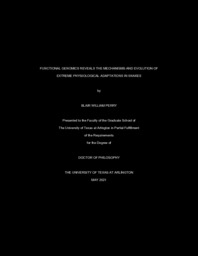
ATTENTION: The works hosted here are being migrated to a new repository that will consolidate resources, improve discoverability, and better show UTA's research impact on the global community. We will update authors as the migration progresses. Please see MavMatrix for more information.
Show simple item record
| dc.contributor.advisor | Castoe, Todd | |
| dc.creator | Perry, Blair William | |
| dc.date.accessioned | 2022-07-19T12:14:38Z | |
| dc.date.available | 2022-07-19T12:14:38Z | |
| dc.date.created | 2021-05 | |
| dc.date.issued | 2021-04-28 | |
| dc.date.submitted | May 2021 | |
| dc.identifier.uri | http://hdl.handle.net/10106/30759 | |
| dc.description.abstract | Previous studies examining post-feeding organ regeneration in the Burmese python (Python molurusbivittatus) have identified thousands of genes that are significantly differentially regulated during this process. However, substantial gaps remain in our understanding of coherent mechanisms and specific growth pathways that underlie these rapid and extensive shifts in organ form and function. Here we addressed these gaps by comparing gene expression in the Burmese python heart, liver, kidney, and small intestine across pre- and post-feeding time points (fasted, one day post-feeding, and four days post-feeding),and by conducting detailed analyses of molecular pathways and predictions of upstream regulatory molecules across these organ systems. Identified enriched canonical pathways and upstream regulators indicate that while downstream transcriptional responses are fairly tissue specific, a suite of core pathways and upstream regulator molecules are shared among responsive tissues. Pathways such as mTOR signaling, PPAR/LXR/RXR signaling, and NRF2-mediated oxidative stress response are significantly differentially regulated in multiple tissues, indicative of cell growth and proliferation along with coordinated cell protective stress responses. Upstream regulatory molecule analyses identify multiple growth factors, kinase receptors, and transmembrane receptors, both within individual organs and across separate tissues Downstream transcription factors MYC and SREBF are induced in all tissues. These results suggest that largely divergent patterns of post-feeding gene regulation across tissues are mediated by a core set of higher level signaling molecules. Consistent enrichment of the NRF2-mediated oxidative stress response indicates this pathway may be particularly important in mediating cellular stress during such extreme regenerative growth. | |
| dc.format.mimetype | application/pdf | |
| dc.language.iso | en_US | |
| dc.subject | Genomics | |
| dc.subject | Evolution | |
| dc.subject | Functional genomics | |
| dc.subject | Gene regulation | |
| dc.subject | Venom | |
| dc.subject | Regeneration | |
| dc.title | FUNCTIONAL GENOMICS REVEALS THE MECHANISMS AND EVOLUTION OF EXTREME PHYSIOLOGICAL ADAPTATIONS IN SNAKES | |
| dc.type | Thesis | |
| dc.degree.department | Biology | |
| dc.degree.name | Doctor of Philosophy in Quantative Biology | |
| dc.date.updated | 2022-07-19T12:14:39Z | |
| thesis.degree.department | Biology | |
| thesis.degree.grantor | The University of Texas at Arlington | |
| thesis.degree.level | Doctoral | |
| thesis.degree.name | Doctor of Philosophy in Quantative Biology | |
| dc.type.material | text | |
Files in this item
- Name:
- PERRY-DISSERTATION-2021.pdf
- Size:
- 110.6Mb
- Format:
- PDF
This item appears in the following Collection(s)
Show simple item record


